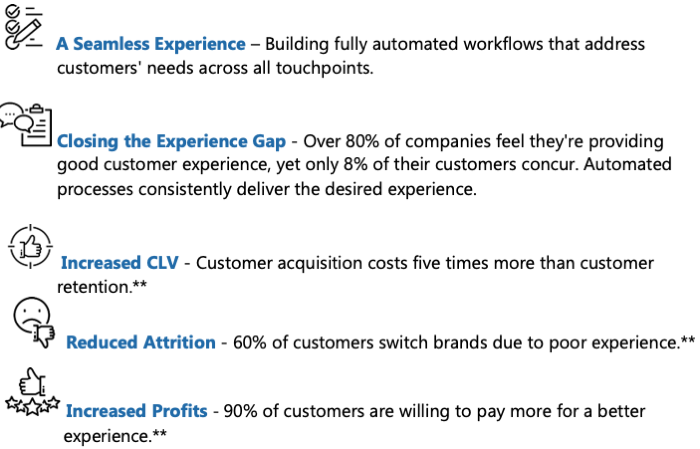Intelligent automation – What is it and how to start

We are heading into the perfect storm: The 4th industrial revolution is upon us. There is a general labor shortage. And to complicate the matter even more, customer expectations are ever evolving. The only certainly about the 4th industrial revolution is that there will be casualties: Automation, IoT, Machine Learning, Robotics, 3D manufacturing are changing the business landscape out of all recognition. This sink-or-swim disruption could mean that in ten years, 50% of the current Fortune 500 companies will cease to exist*.
The Harvard Business Review believes that to survive these upheavals, and to remain competitive and differentiated, we have three options:
- Slash prices (very painful & sometimes not a viable option)
- Dream up ground-breaking products and services (not an easy task in a highly regulated market)
- Create world-class Customer Experience (CX)
CX – the most viable option – is where Intelligent Automation enters the equation. Exceptional CX relies on efficient and repeatable business processes. These elements can be systematically delivered with automation.
IA projects that are focused on CX have resulted in:

*Source, Professor Mark J. Perry University of Michigan’s Flint campus **Invespcro.com/blog-customer-acquisition-retention/
Why so much talk about business process?
Client experience fundamentally relies on business processes and business processes rely equally on existing IT systems and your talent pool. Changing systems to gain efficiencies are time consuming and expensive. Upskilling your talent pool, given attrition rates, is a wall that is hard to scale and organizations find it hard to gain traction. However, IA when deployed correctly, can change the entire paradigm because:
- You don’t have to change any systems in order to improve process and data flow – automation tools “sit on top” of your existing infrastructure to facilitate work and data flow.
- You don’t have to rely on training or Standard Operating Documents to help your staff remember what to do in all the possible ways a customer request can be processed – Automation will take over the business rules of a transaction and the in turn, you reduce the need to have inspections and allow your staff to focus on value-creating tasks.
- Cost savings and improved compliance/reduction of risk is a certainty. When processes are streamlined and automated, work that used to take hours or minutes can be completed in seconds using robotics.
What is intelligent automation (IA)?
IA is the integration of robotics with multiple components from different emerging technologies. Its three main components are: Robotic Process Automation (RPA), Artificial Intelligence (AI) and Business Process Management (BPM). RPA focuses on the automation of the highly repetitive and mundane tasks. Artificial Intelligence uses data to constantly learn and mimic human thinking so that it can automate the more complex activities. And Business Process Management principles ensures that processes are well understood and optimized prior to automation.
It is important to note that successful IA initiatives rely on two central ideas:
- That business processes have been examined, root causes of inefficiency are understood and the process is re-engineered to perform at its highest level
- There is awareness of which IA technologies will be needed to overcome those inefficiencies and enable the best automated version of that process
It is like solving a puzzle, you have to know your desired end state and have the knowledge of what pieces of technology are available to get you there.
What is the best way to start an IA journey?
The biggest challenges that anyone will have with IA are WHERE to start and HOW MUCH will it cost. The most effective way of starting with an automation journey is with a one or two-day workshop during which time your business leaders will:
- Get introduced to the various automation capabilities
- Learn where their peers have applied these tools
- Spend time exploring where the technology could be applied in their lines of business before any decisions on tools & licenses are made
There are simply too many automation technology tools (Chatbot, Intelligent Character Recognition, Optical Character Recognition, Image Recognition, RPA, Natural Language Processing…) and vendors (Microsoft, UiPath, AutomationAnyWhere, Appian, NICE, Jiffy.ai…) to sift through. Unfortunately, there is no simple answer for “how to start” because every organizations’ objectives, risk tolerance and budget is different.
The cost component of automation is reliant on the design and implementation of the solution (typically outsourced to a technology company). To give you a rough idea of design and implementation costs – a simple process can cost $15-$25K, a medium complexity process can be $35-$60K and a complex process can run upwards of $150K. So, ensuring that you are picking the “right” process is important in ensuring a robust ROI.
IA is a journey, typically started with a proof-of-concept deployment. This allows stakeholders to gauge the tolerance level of leadership in driving change and to understand (first hand) the challenges that the organizations will face (cultural, technological, political). Companies that have successfully deployed it have reaped millions of dollars in operational efficiency, while differentiating themselves. Frankly, given the cost of system conversions and upgrades, IA may just be path of least resistance to taking your organization to the next level.
If you want to explore your IA options, consider giving our team at ProcessArc a call.

